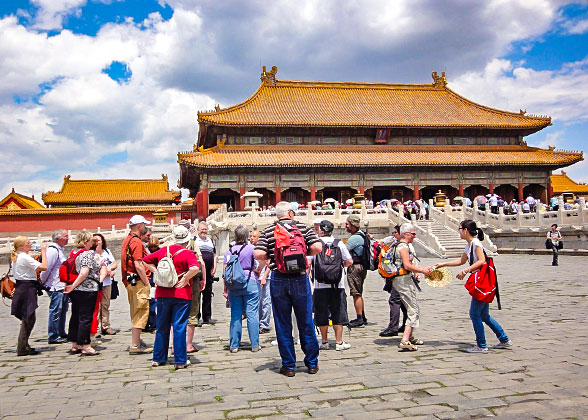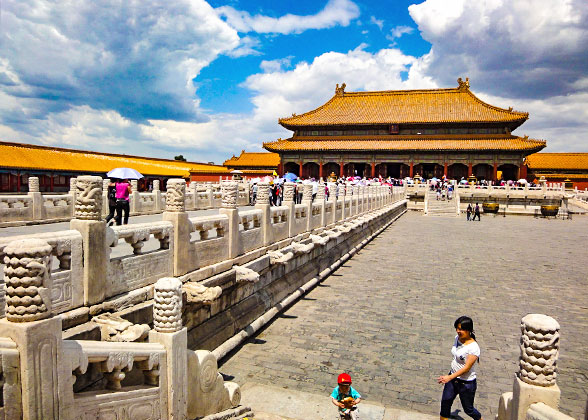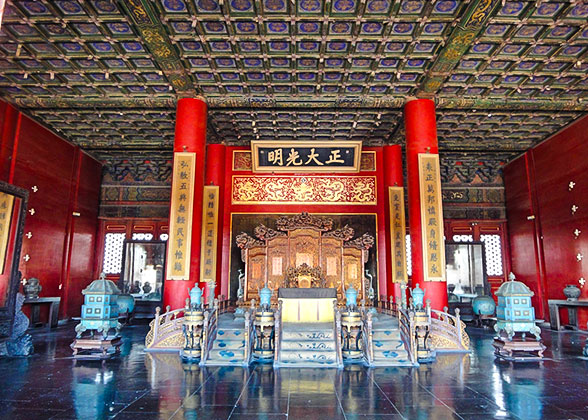Palace of Heavenly Purity (Qianqinggong)
Inside Gate of the Heavenly Purity (Qianqingmen), you will see the Palace of Heavenly Purity (Qianqinggong or Palace of Celestial Purity). This was the sleeping quarters of the emperors inside Forbidden City.
The Palace of Heavenly Purity is a smaller version of the Hall of Supreme Harmony. As it was deemed inferior to the Hall of Supreme Harmony everything within it is smaller than similar items in the superior palace. However, it is the largest palace in the Inner Court of Forbidden City and it is superior to any other structures there. The Palace of Heavenly Purity was built in 1420 and rebuilt in 1798 as a consequence of fire damage Ming emperors and the first two Qing emperors lived in and attended to daily affairs of state. Here they also read, and signed documents, interviewed ministers and envoys. Occasionally, banquets and other ceremonies would be held here too.
Twice, in 1722 and 1785, a 'Banquet for A Thousand Seniors' was held here . Old men over 60 from the nation attended these events. Emperor Qianlong even gave them presents. Later, Emperor Yongzheng moved his living quarters to the Hall of Mental Cultivation, which is located to the west. Nevertheless, it continued to play a significant role in the imperial life.
Moreover, in the Qing Dynasty, no matter where the emperor died, his coffin would be placed in the Palace of Heavenly Purity for a few days for memorial ceremonies. Later the coffin would be moved to Jinshan, and then buried in the mausoleum on a selected day.
In the centre, the throne is on a raised dais, surrounded by cloisonne incense burners, long red candles, and large mirrors, which were placed beside the throne to ward off evil spirits. On the surrounding columns, there are two pairs of couplets written by Qing emperors. Over the throne hangs a plaque engraved with four Chinese characters, written by Emperor Yongzheng and which mean 'Justice and Brightness.' From the time of Emperor Yongzheng, the name of each crown prince would be written on duplicate documents and a copy would be placed in a box behind this plaque. The other copy would be retained by the emperor. Only if the name on each document was the same would the designated prince take the crown upon the death of the emperor.
 Next:
Next:
Go north to see the Hall of Celestrial and Terrestial Union (Jiaotaidian).
 Further Reading:
Further Reading:
How to visit the Forbidden City
‘Banquets for a Thousand Seniors’ in the Forbidden City
Ancient Festival Lanterns in the Forbidden CityThe Palace of Heavenly Purity is a smaller version of the Hall of Supreme Harmony. As it was deemed inferior to the Hall of Supreme Harmony everything within it is smaller than similar items in the superior palace. However, it is the largest palace in the Inner Court of Forbidden City and it is superior to any other structures there. The Palace of Heavenly Purity was built in 1420 and rebuilt in 1798 as a consequence of fire damage Ming emperors and the first two Qing emperors lived in and attended to daily affairs of state. Here they also read, and signed documents, interviewed ministers and envoys. Occasionally, banquets and other ceremonies would be held here too.
 |
| Palace of Heavenly Purity |
Moreover, in the Qing Dynasty, no matter where the emperor died, his coffin would be placed in the Palace of Heavenly Purity for a few days for memorial ceremonies. Later the coffin would be moved to Jinshan, and then buried in the mausoleum on a selected day.
In the centre, the throne is on a raised dais, surrounded by cloisonne incense burners, long red candles, and large mirrors, which were placed beside the throne to ward off evil spirits. On the surrounding columns, there are two pairs of couplets written by Qing emperors. Over the throne hangs a plaque engraved with four Chinese characters, written by Emperor Yongzheng and which mean 'Justice and Brightness.' From the time of Emperor Yongzheng, the name of each crown prince would be written on duplicate documents and a copy would be placed in a box behind this plaque. The other copy would be retained by the emperor. Only if the name on each document was the same would the designated prince take the crown upon the death of the emperor.
|
|
Go north to see the Hall of Celestrial and Terrestial Union (Jiaotaidian).
How to visit the Forbidden City
‘Banquets for a Thousand Seniors’ in the Forbidden City
Miraculous Sundials in the Forbidden City
Smallest Palace in the Forbidden City
'Tiger Caves': Secret Passages in the Forbidden City
- Last updated on Aug. 16, 2024 by Gabby Li -

